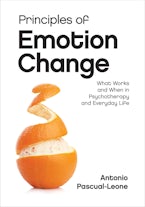Introduction
CHAPTER 1: A General Theory of Emotional Change
PART I – REDUCE INTENSITY
CHAPTER 2: Down-Regulating Emotional Intensity
CHAPTER 3: Avoidance, Desensitization, and Behavioral Coping
PART II: NOTICE THE FEELING
CHAPTER 4: Emotional Awareness: From Engagement to Symbolization
CHAPTER 5: Emotional Engagement: Getting in Touch With What’s There
CHAPTER 6: Labeling Emotion: Finding Just the Right Words
CHAPTER 7: Deepening Emotion Through Symbolization
PART III: FEEL MORE, EXPRESS MORE
CHAPTER 8: Heightening Arousal, Vividness, Expression, and Enactments
CHAPTER 9: Getting Physical: Working From the Outside In
CHAPTER 10: Enactments: Working From the Inside Out
CHAPTER 11: Proclamation of Self: “I Felt It, I Said It, I Did It!”
PART IV: ORDER THE SEQUENCE OF EMOTIONS
CHAPTER 12: Sequential Transformation: The Pattern in Emotion Makes the Change
CHAPTER 13: Changing Emotion With Emotion: The Process in Action
CHAPTER 14: Adult Emotional Development: Expanding One’s Repertoire
CHAPTER 15: The Sequential Model: “The Only Way Out is Through”
CHAPTER 16: Tracking Sequences: The Roller Coaster to Resolution
PART V: PUT THE FEELING IN CONTEXT
CHAPTER 17: Using Context and Narrative: “The Big Picture”
CHAPTER 18: Psychological Elaboration: Telling More of the Story
CHAPTER 19: We Have Relationship With Our Memories: Revising the “Meta-Data”
CHAPTER 20: Stepping Out of the Frame: “I Am Myself and My Circumstances”
CHAPTER 21: Life Narrative and Identity: The Story Itself Is an Agent of Change
CHAPTER 22: Storying the Self: “It’s a Matter of Perspective . . ."
CHAPTER 23: Having Purpose and Making Choices
PART VI: CONCLUSIONS: A NEW PARADIGM
CHAPTER 24: A General Theory of Emotion Change
References
Index
About the Author

